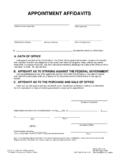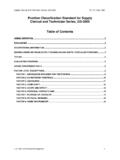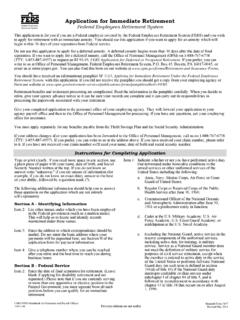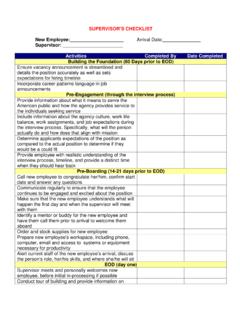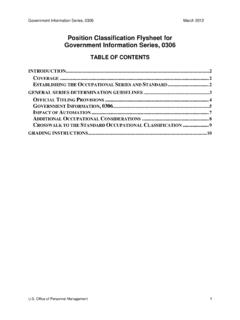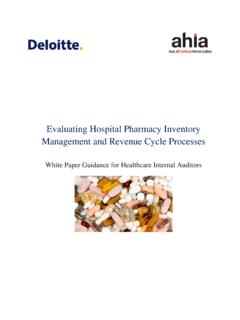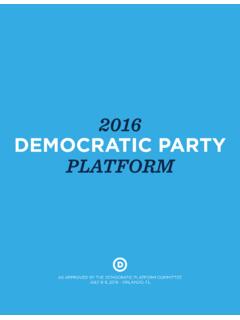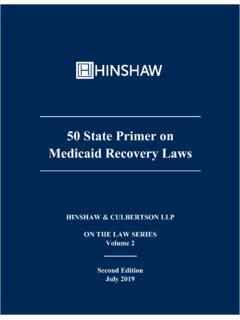Transcription of 2021 Federal Benefits Open Season Highlights
1 Benefits Open SeasonUnited StateS Office Of PerSOnnel ManageMentNovember 8, 2021 December 13, 2021 SEPTEMBER 2021 Federal Benefits Open Season Highlights 2022 Plan Year The Federal Benefits Open Season for the 2022 plan year for health insurance under theFEHB Program, dental and vision insurance under FEDVIP and flexible spending accountsunder FSAFEDS will be held from November 8 through December 13, 2021. FederalBenefits Open Season gives Federal employees and other eligible individuals the opportunityto review their plans, make changes, and enroll in one of 275 FEHB plan choices for is also the time for annuitants to re-evaluate their plans and decide if they are optimallycovered.
2 Every year, on behalf of our million enrollees, OPM focuses on offering quality andaffordable health , dental and vision Benefits to Federal employees, annuitants, and theirfamilies. For the 2022 plan year, we once again have succeeded in meeting that goal. Throughout this national pandemic, OPM has worked with our FEHB Carriers to ensure thatour enrollees have ready access to COVID-related Benefits , with no cost sharing. With eachnew hurdle presented by the pandemic, FEHB Carriers have risen to the challenge, providingquick solutions to provide COVID-19 testing and vaccines, telehealth, and mental healthbenefits to our Federal enrollees, and encouraging enrollees to get vaccinated, with manyoffering incentives to those who do!
3 We thank them for their commitment and support. The FEHB Program is market-based, centered on choice and competition; therefore, it is notsurprising that in most cases, major drivers of costs in the FEHB Program mimic those seenin the commercial market. Among these cost drivers are pharmacy spending as new,expensive specialty drugs enter the market, chronic illness costs, and medical technology andinnovation. TribesoIn 2010, the Affordable care Act added section 409 to the Indian health CareImprovement Act (IHCIA), entitling certain Indian Tribes, Tribal organizations, andurban Indian organizations to purchase coverage, rights, and Benefits under the FEHBP rogram for their tribal the Consolidated Appropriations Act, Fiscal Year 2021 (Public Law 116-260)a tribal grant school may now choose to purchase FEHB coverage for its , there are over 4,500 employees of tribal grant schools.
4 The inclusion oftribal grant schools will have a positive impact by providing equal access to theseschools that could not previously access FEHB Benefits coverage for their employees,which was extended to other Tribal employers under the Affordable care of September 3, 2021, five tribal grant schools have purchased FEHB coverage for446 enrollees, and an additional five schools will start offering FEHB coverage laterthis , 132 Tribes/Tribal organizations/urban Indian organizations/tribal grantschools have purchased FEHB coverage for approximately 32,000 of their tribalemployees with a total of 64,000 covered lives (enrollees and family members).
5 2 FEHB Rates and Changes FEHB Rates: For more than 60 years, the FEHB Program has been the largest employer-sponsored health insurance program in the United States, providing health insurance Benefits for about million Federal civilian employees, annuitants and their families and certain Tribal employees and their families. The Government's share of premiums paid is set by law. This formula is known as the "Fair Share" formula because it is designed to maintain a consistent level of Government contributions, as a percentage of total program costs, regardless of which health plan enrollees elect. The overall average increase in rates for Federal employees and annuitants (excluding postal actives) for 2022 is The average Government contribution for Federal employees and annuitants (excludingpostal active employees) will increase by The average enrollee share for Federal employees and annuitants (excluding postal activeemployees) will increase an average of For 2021 we estimate the biweekly average Federal employee salary (excluding Postalemployees) is about $3,504 and the average enrollee share of premium for non-postal andannuitants is $ , or about of salary.
6 For 2022, assuming a salaryincrease, the average salary will increase to $3,599. Without open Season movement,average enrollee premium will be about $ , or about of salary. A rates chart is offered on that provides the actual dollar premium increase foreach FEHB plan choice and enrollment Sized Employers: The FEHB Program average premium increase for 2022 compares quite favorably to reported increases by comparable large employers. On July 13, CalPERS announced rate and plan changes for 2022 that include an overall premium increase. CalPERS is the largest purchaser of public employee healthbenefits in California, and the second largest public purchaser in the nation after the federalgovernment.
7 CalPERS serves more than million members and their families in theirhealth program. PriceWaterhouseCoopers health Research Institute (HRI) projects a growth rate inmedical costs for calendar year 2022 based on information available as of June 2021, slightlylower than the 7% medical cost trend in 2021. Their projection incorporates interviews withhealth Benefits experts and health plan actuaries whose companies cover nearly 90 million3 employer-sponsored large group (with at least 50 employees per Affordable care Act) members. Key findings include: Employer healthcare spending in 2020 was lower than originally projected primarilydue to the deferral of care because of the pandemic.
8 Costs for COVID-19 testing, vaccine administration, and costs for treating patientswith COVID-19 are expected to continue for 2022. Demand for mental health services and substance use disorder are expected toincrease in 2022 and impact healthcare costs. Thirty percent of Americans withemployer- based insurance surveyed by HRI said they had experienced symptoms ofanxiety or depression because of the pandemic. The Business Group on health (formerly the National Business Group on health ) conducteda survey of 136 large employers covering more than 8 million lives in 2021, looking ahead to2022. BGH found that for 2022, employers expect cost trend to decline slightly to plan design changes that address COVID-19, social determinants of health , expandingaccess to mental health care , and virtual health are made.
9 Due to the impact of deferred careand pent-up demand as a result of COVID, employers anticipate seeing an increase inmedical services, late-stage cancer diagnoses, greater numbers of people with long-termmental health and substance use issues and other adverse effects that could last well intofuture years. This is attributed to many people staying at home during the numerouslockdowns, and doctor visits and preventative screenings were delayed or missed Cost Drivers Impacting 2022 Premiums: FEHB Carriers indicate that the top contributors to their 2022 rate increase are specialtydrugs, medical pharmacy (drugs that are billed on the medical benefit), chronic illness costs,and medical technology and innovation.
10 The 2022 rate increase was partially offset by lowerthan anticipated utilization during the early months of the COVID pandemic that was notfully captured in 2021 rates as well as FEHB Carrier renegotiation of PBM contracts. Increasing costs related to COVID-19 and mental health were also mentioned by severalFEHB Carriers. The coronavirus pandemic cost the FEHB Program about $1 billion (2% of 2020 claims) totest and treat COVID-19 patients (COVID-specific claims information is only available for2020. Complete 2021 claim cost data will not be available until June of 2022.)The pandemic-related costs will likely persist in 2022 but potentially decline due to more vaccinations available for our population, especially with the various vaccination mandate/requirements at the workplace issued by the Federal Government, state and local governments, as well as employers in the private sector.

